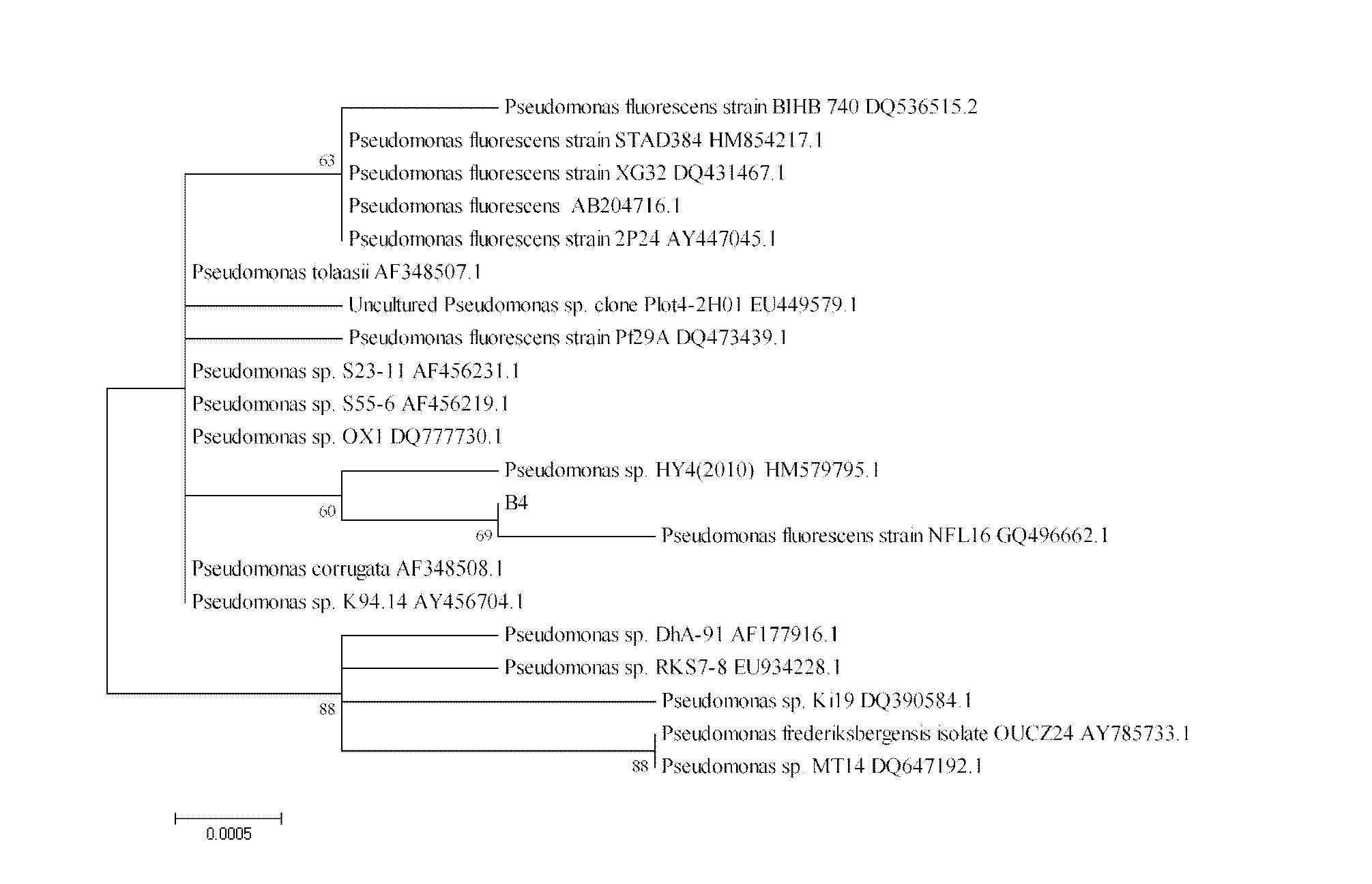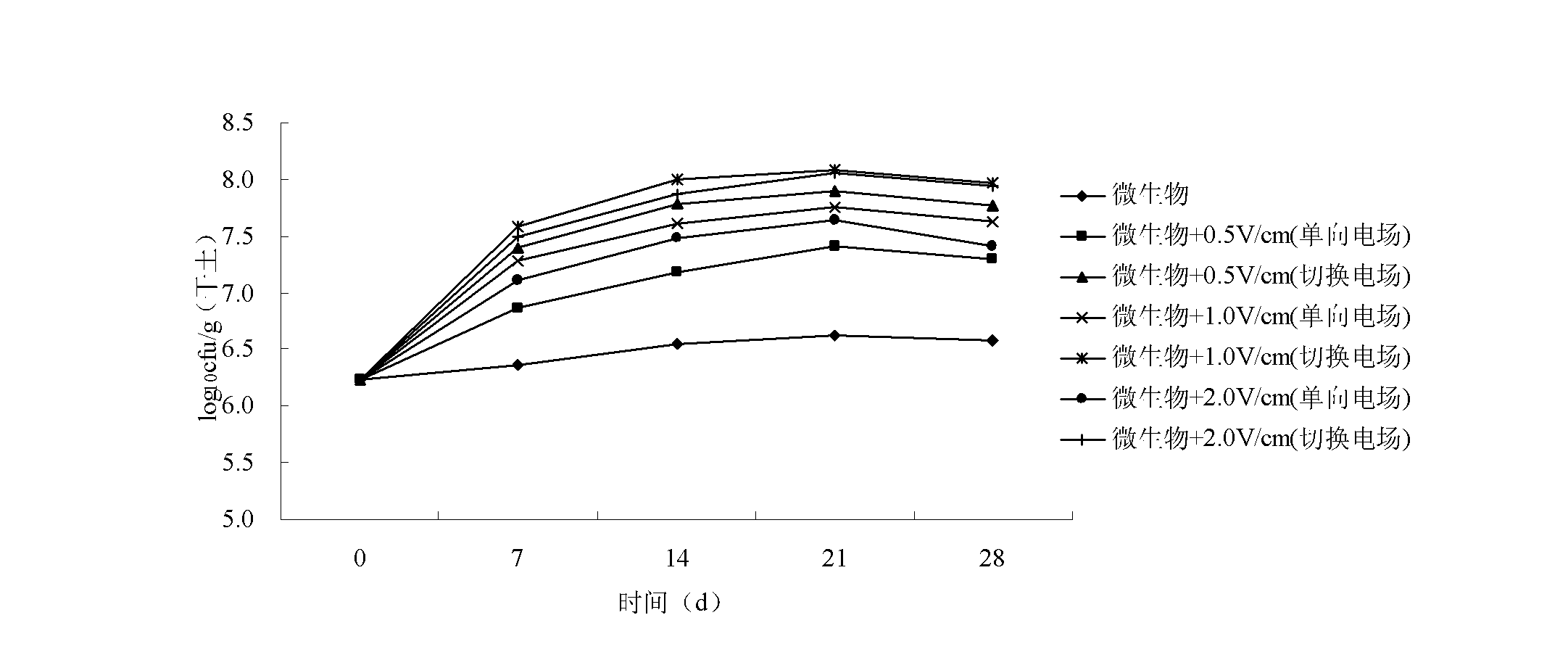Polycyclic aromatic hydrocarbon degrading bacterium suitable for electric field condition and application thereof
A polycyclic aromatic hydrocarbon, degrading bacteria technology, applied in the direction of microorganism-based methods, bacteria, and the restoration of polluted soil, etc., can solve the problems of affecting the activity of degrading microorganisms, reducing the degradation effect, affecting the bioremediation process, etc., and achieve good social benefits. , the effect of enhancing the degradation activity and improving the degradation ability
- Summary
- Abstract
- Description
- Claims
- Application Information
AI Technical Summary
Problems solved by technology
Method used
Image
Examples
Embodiment 1
[0020] Isolation and Screening of Pseudomonas fluorescens PB4
[0021] CCTCC No: Isolation and Screening of M 2011260
[0022] The sample comes from the PAH-contaminated soil around Benxi Iron and Steel Company. Weigh 5.0g of soil, add 50ml of sterile water and shake for 30min, then absorb the supernatant and enrich and culture it in the liquid inorganic salt medium containing 100mg / L PAH for 3d Finally, streak and isolate on a solid inorganic salt medium containing 100 mg / L polycyclic aromatic hydrocarbons, select a well-growing single colony, streak, isolate and purify three times, and then store the bacterial strain on a slant medium.
[0023] The composition of described liquid inorganic salt culture medium: MgSO 4 .7H 2 O 0.2g; CaCl 2 .2H 2 O 0.01g; FeSO 4 .7H 2 O 0.005g; K 2 HPO 4 0.4g; MnSO 4 .H 2 O 0.02g; NH 4 NO 3 1.0g; Na 2 HPO 4 0.6g; distilled water 1000ml; pH 7.2-7.4, sterilized at 121°C for 30min.
[0024] The solid inorganic salt medium: MgSO ...
Embodiment 2
[0027] Example 2 PCR amplification and sequence determination of the 16S rDNA gene of Pseudomonas fluorescens (Pseudomonas fluorescens) PB4
[0028] The total DNA of the above strain Pseudomonas fluorescens PB4 was extracted, and the 16S rDNA of the strain was amplified. The primers for PCR amplification were universal primers for bacteria, 27f: 5'-AGAGTTTGATCCTGGCTCAG-3', 1492R: 5'-GGTTACCTTGTTACGACT-3'. The PCR reaction conditions were: 94°C for 3min; 94°C for 1min, 55°C for 1min, 72°C for 3min, 35 cycles; 72°C for 10min. After the PCR amplification product is purified, it is sequenced, and the result and the sequence on Genbank are subjected to Blast analysis. The sequence length is 1424bp, and the phylogenetic tree of its 16S rDNA gene sequence (see figure 1 ), it can be seen that the above-mentioned isolated bacterial strain has great homology with Pseudomonas fluorescens.
Embodiment 3
[0029] Example 3 Determination of biological activity of Pseudomonas fluorescens PB4.
[0030] The above Pseudomonas fluorescens (Pseudomonas fluorescens) PB4 was inoculated in beef extract peptone liquid medium, and then shaken and cultured at 28°C and 150r / min constant temperature shaker for 3 days; Phosphate buffer was diluted, and the resulting diluent (phosphate buffer composition: KH 2 PO 4 34.0g; 175ml of 1mol / L NaOH solution; 825ml of distilled water; pH7.2; preparation of diluent: take 1.25ml of phosphate buffer, dilute to 1000ml with distilled water, and autoclave at 121°C for 30min) to prepare the bacteria into a suspension. The prepared bacterial suspension of Pseudomonas fluorescens (Pseudomonas fluorescens) PB4 was added to sterilized clean sandy loam, and the concentration of Pseudomonas fluorescens in the soil was 1.7×10 6 CFU / g dry soil. At the same time, unidirectional and switching electric fields were applied to the test soil, the voltages were 0.5V / cm,...
PUM
 Login to View More
Login to View More Abstract
Description
Claims
Application Information
 Login to View More
Login to View More - R&D
- Intellectual Property
- Life Sciences
- Materials
- Tech Scout
- Unparalleled Data Quality
- Higher Quality Content
- 60% Fewer Hallucinations
Browse by: Latest US Patents, China's latest patents, Technical Efficacy Thesaurus, Application Domain, Technology Topic, Popular Technical Reports.
© 2025 PatSnap. All rights reserved.Legal|Privacy policy|Modern Slavery Act Transparency Statement|Sitemap|About US| Contact US: help@patsnap.com



